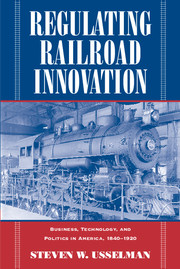Book contents
- Frontmatter
- Contents
- List of Illustrations
- Preface and Acknowledgments
- Introduction
- Part I ASSEMBLING THE MACHINE, 1840–1876
- 1 Engines of Expansion and Extraction: The Politics of Development
- 2 Acquiring Technology: Insider Innovation
- 3 Patent Problems: Inventors and the Market for Technology
- Part II RUNNING THE MACHINE, 1876–1904
- Part III FRICTION IN THE MACHINE, 1904–1920
- Epilogue: The Enduring Challenge of Innovation
- Index
1 - Engines of Expansion and Extraction: The Politics of Development
from Part I - ASSEMBLING THE MACHINE, 1840–1876
Published online by Cambridge University Press: 12 August 2009
- Frontmatter
- Contents
- List of Illustrations
- Preface and Acknowledgments
- Introduction
- Part I ASSEMBLING THE MACHINE, 1840–1876
- 1 Engines of Expansion and Extraction: The Politics of Development
- 2 Acquiring Technology: Insider Innovation
- 3 Patent Problems: Inventors and the Market for Technology
- Part II RUNNING THE MACHINE, 1876–1904
- Part III FRICTION IN THE MACHINE, 1904–1920
- Epilogue: The Enduring Challenge of Innovation
- Index
Summary
When a dying Ulysses S. Grant sat down to pen his memoirs, he had no doubts about where to begin. The great epic of disunion and reunion that Grant saw as the centerpiece both of his own life and that of the young nation he had served could be traced back to 1846 and the decision to wage war against Mexico. Grant understood that the Mexican War had unleashed transforming forces no one had fully anticipated and no institution could fully contain. By opening broad untrammeled vistas, both real and imagined, the war at once presented Americans with startling new economic opportunities and compelled them to rethink the very nature of their society and nation. The bloody sectional conflict that eventually drew Grant from obscurity and thrust him into the public limelight was but one momentous result; the path to the Civil War involved far more than the end of slavery. It entailed a fundamental restructuring of American economic life around dynamic new nodes of activity: mining and ranching in the Mountain West; wheat, corn, and hogs across the upper Midwest; timber along the northern reaches of the Great Lakes; coal, iron, and oil back to the settled East and old Northwest. In every section of the country, Americans combed the land, dug into its surface, and plucked from it spectacular returns.
- Type
- Chapter
- Information
- Regulating Railroad InnovationBusiness, Technology, and Politics in America, 1840–1920, pp. 15 - 60Publisher: Cambridge University PressPrint publication year: 2002

